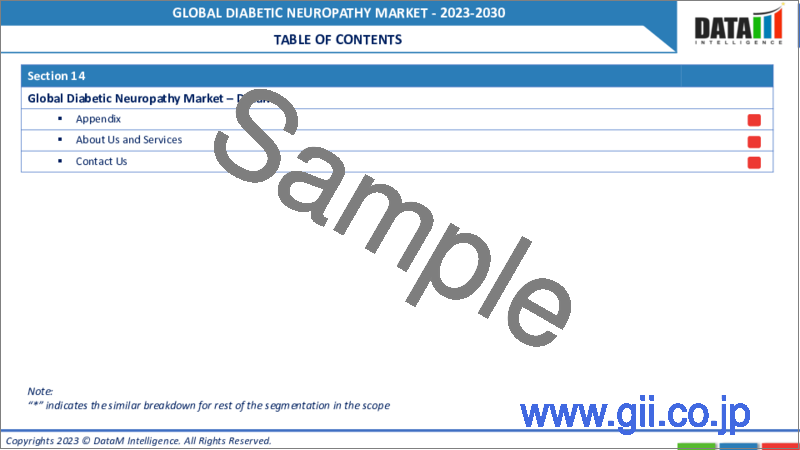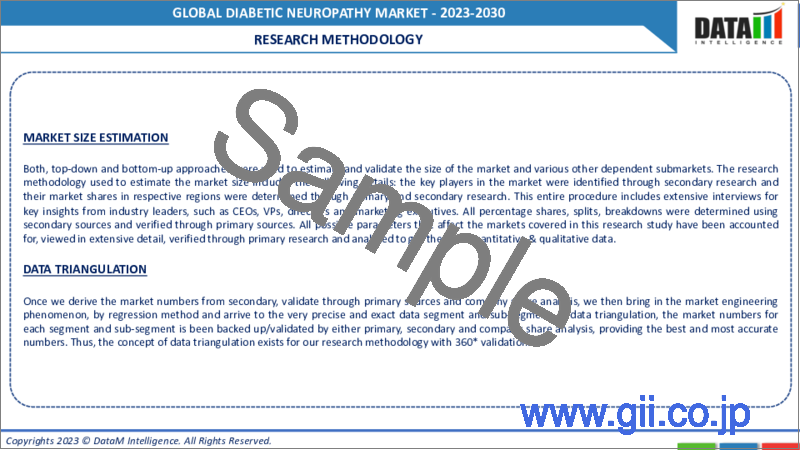|
|
市場調査レポート
商品コード
1285064
糖尿病性神経障害の世界市場- 2023-2030年Global Diabetic Neuropathy Market - 2023-2030 |
||||||
カスタマイズ可能
適宜更新あり
|
|||||||
| 糖尿病性神経障害の世界市場- 2023-2030年 |
|
出版日: 2023年06月05日
発行: DataM Intelligence
ページ情報: 英文 195 Pages
納期: 即日から翌営業日
|
- 全表示
- 概要
- 目次
市場概要
糖尿病性神経障害の世界市場は、2022年に37億7,540万米ドルに達し、2030年には62億9,810万米ドルに達することで有利な成長を示すと予測されます。糖尿病性神経障害市場は、予測期間中(2023-2030年)に6.7%のCAGRを示すと予測されています。
糖尿病性神経障害は、糖尿病のために神経に引き起こされる悪化であり、通常、足や下肢の痛みや感覚の喪失を引き起こします。また、神経障害の影響により、腰、手首、背中など様々な部位に痛みが生じることがあります。神経障害には、局所神経障害、近位神経障害、末梢神経障害、自律神経障害など、さまざまな種類があります。
糖尿病患者や老年人口の増加、さまざまな政府組織による資金調達イニシアチブの増加が、世界の糖尿病性神経障害市場の成長を後押ししています。
市場力学
老年人口の増加が、予測期間中、糖尿病性神経障害の世界市場を牽引すると予想されます。
神経障害は65歳以上の高齢者に典型的にみられ、その優位性は年齢とともに高まります。したがって、老年人口の増加が糖尿病性神経障害の世界市場を牽引しています。例えば、国連の「World Population Prospects 2022」によると、80歳以上の人口は2022年の1億5,700万人から2050年には4億5,900万人と3倍に増加すると予想されています。
様々な政府機関からの資金提供の増加が糖尿病性神経障害の世界市場に有望な成長機会をもたらす
さまざまな政府機関からの資金提供の増加は、世界の糖尿病性神経障害市場に有利な成長機会をもたらしています。例えば、米国保健福祉省は、インディアンヘルスサービスを通じて、2023会計年度のインディアン向け特別糖尿病プログラム(SDPI)に1億3,900万米ドルを出資し、米国アラスカおよびインディアン先住民のコミュニティに糖尿病の予防と治療の支援を提供しています。
COVID-19の影響分析
COVID-19の分析には、Pre-COVIDシナリオ、COVIDシナリオ、Post-COVIDシナリオがあり、価格力学(パンデミック時およびパンデミック後の価格変動とCOVID前のシナリオとの比較)、需給スペクトル(取引制限、ロックダウンおよびその後の問題による需要と供給のシフト)、政府の取り組み(政府機関による市場、セクター、産業の再生への取り組み)、メーカー戦略への取り組み(COVID問題を軽減するためのメーカーの取り組み)についても解説しています。
ロシア・ウクライナ戦争の影響分析
ウクライナの慢性疾患患者が現在直面している問題は、電気、暖房、清潔な水といった基本的な要件が満たされない中、慢性疾患の治療薬などの医療サポートが侵略のために不足していることで増加しています。このように、ロシア・ウクライナ戦争は、世界の糖尿病性神経障害市場に悪影響を及ぼしています。
世界同時不況の影響分析
ヘルスケア業界は不況に対して完全に無防備というわけではなく、過去の不況時にはレイオフや雇い止めが行われました。しかし、医療業界は他業界と比較して、より良い経営を行っています。しかし、景気後退の脅威は、インフレが成功するにつれて、市場を危険にさらします。
先進諸国における高インフレの進行に伴う景気後退の懸念は、過去2年間において全方位的な価格変動となって表れています。
人工知能の影響分析
AIは世界の糖尿病性神経障害市場にプラスの影響を与えると予想されます。ビッグデータ・プールを処理するAIの能力により、患者の経験を組み合わせることで予測的な利益をもたらし、ヘルスケア・エコシステムが修正が必要な患者ケアの主要な側面を明らかにできるようになるからです。
目次
第1章 調査手法と範囲
- 調査手法
- 調査目的および調査範囲
第2章 定義と概要
第3章 エグゼクティブサマリー
- タイプ別スニペット
- 薬物タイプ別スニペット
- スニペット:販売チャネル別
- 地域別スニペット
第4章 市場力学
- 影響要因
- 促進要因
- 糖尿病患者の増加
- 市場開拓
- 抑制要因
- 規制当局の厳しさ
- 機会
- 政府の取り組み
- 影響分析
- 促進要因
第5章 産業分析
- ポーターの5フォース分析
- 法規制分析
- 価格分析
- 特許分析
第6章 COVID-19の分析
- COVID-19の分析
- COVID-19の前のシナリオ
- COVID-19期間中のシナリオ
- COVID-19後のシナリオと今後のシナリオ
- COVID-19の中での価格・ダイナミクス
- 需給スペクトル
- パンデミック時の市場に関連する政府の取り組み
- メーカー各社の戦略的取り組み
- サマリー
第7章 ロシア・ウクライナ戦争の分析
第8章 世界同時不況の分析
第9章 人工知能分析
第10章 タイプ別
- 末梢性ニューロパチー
- 自律神経系ニューロパチー
- 近位型ニューロパチー
- フォーカルニューロパシー
第11章 薬物クラス別
- 抗うつ剤
- 抗けいれん薬
- オピオイド
- 非ステロイド系抗炎症薬
- その他
第12章 販売チャネル別
- 病院・診療所薬局
- 小売薬局・店舗・店
- オンライン薬局
第13章 地域別
- 北米
- 米国
- カナダ
- メキシコ
- 欧州
- ドイツ
- 英国
- フランス
- イタリア
- スペイン
- その他欧州
- 南米
- ブラジル
- アルゼンチン
- その他南米地域
- アジア太平洋地域
- 中国
- インド
- 日本
- オーストラリア
- その他アジア太平洋地域
- 中東・アフリカ地域
第14章 競合情勢
- 競合シナリオ
- 市場シェア分析
- M&A(合併・買収)分析
第15章 企業プロファイル
- Depomed Pharma
- 会社概要
- 製品ポートフォリオと概要
- 財務概要
- 主な発展状況
- Eli Lilly and Company
- Daiichi Sankyo
- Teva Pharmaceutical Industries Ltd.
- Xenoport
- Grunenthal
- Johnson and Johnson
- Pfizer
- GlaxoSmithKline
- Boehringer Ingelheim
第16章 付録
Market Overview
The global diabetic neuropathy market reached USD 3,775.4 million in 2022 and is projected to witness lucrative growth by reaching up to USD 6,298.1 million by 2030. The diabetic neuropathy market is expected to exhibit a CAGR of 6.7% during the forecast period (2023-2030).
Diabetic neuropathy is the deterioration induced to the nerve because of diabetes, which usually causes pain and loss of sensation in the feet or lower legs. The pain can be encountered in different body parts like hips, wrists, and back based on the impact of neuropathy. There are different types of neuropathy like focal neuropathy, proximal neuropathy, peripheral neuropathy, and autonomic neuropathy.
The growing number of diabetes patients and the geriatric population, and increasing funding initiatives from various government organizations are driving the global diabetic neuropathy market growth.
Market Dynamics
The Growing Geriatric Population is Expected to Drive The Global Diabetic Neuropathy Market Over The Forecast Period.
Neuropathies are exceptionally typical in individuals over 65 years old and their preponderance upsurges with age. Thus, the growing geriatric population is driving the global diabetic neuropathy market. For instance, according to the World Population Prospects 2022, from the UN, the number of individuals aged 80 or above is anticipated to grow triple fold, from 157 million in 2022 to 459 million by 2050.
The Increasing Funding from Various Government Organizations is Providing the Global Diabetic Neuropathy Market with Prospective Growth Opportunities
The increasing funding initiatives from various government organizations are presenting the global diabetic neuropathy market with lucrative growth opportunities. For instance, the U. S. Department of Health and Human Services, via the Indian Health Service, is funding $139 million for the Fiscal Year 2023 Special Diabetes Program for Indians (SDPI) to deliver diabetes prevention and therapy assistance for American Alaska and Indian Native communities.
COVID-19 Impact Analysis
The COVID-19 analysis includes Pre-COVID Scenario, COVID Scenario, and Post-COVID Scenario along with pricing dynamics (including pricing change during and post-pandemic comparing it to pre-COVID scenarios), demand-supply spectrum (shift in demand and supply owing to trading restrictions, lockdown, and subsequent issues), government initiatives (initiatives to revive market, sector or industry by government bodies) and manufacturers strategic initiatives (what manufacturers did to mitigate the COVID issues will be covered here).
Russia-Ukraine War Impact Analysis
The issues that are currently being encountered by individuals with chronic conditions in Ukraine are increased by a deficiency of medical support such as medications for chronic disorders at a time when fundamental requirements like electricity, heating, and clean water are not being attended, to because of the invasion. Thus, the Russia-Ukraine war has negatively impacted the global diabetic neuropathy market.
Global Recession Impact Analysis
The healthcare industry is not completely invulnerable to a recession, as healthcare organizations supposed layoffs and hirings in past financial downturns. That remarked the enterprise does manage better compared to different sectors. Yet, the threat of recession risks the market as inflation succeeds.
The extended degree of stress concerning the ongoing recession as the high inflation in developed countries worldwide has transpired in an all-around price ripple through the past two years.
Artificial Intelligence Impact Analysis
AI is anticipated to hold a positive influence on the global diabetic neuropathy market as with AI's capacity to process big data pools, combining patient experiences can direct to predictive benefits, enabling the healthcare ecosystem to expose key dimensions of patient care that need revision.
Segment Analysis
The global diabetic neuropathy market is segmented based on type, drug class, distribution channel, and region.
The NSAIDS Segment is Estimated To Hold a 35.4% Share of the Global Market
The NSAIDs segment is estimated to hold the largest share of the global diabetic neuropathy market, owing to the easy availability of the NSAIDs as are over the counter and hence, readily available for patients in their residents. Additionally, majority of the NSAIDs have their generic formulations obtainable in the market making them affordable and these drugs deliver quick relief without any severe side effects.
Geographical Analysis
Europe is Estimated to Hold the Second-Largest Share of the Global Diabetic Neuropathy Market During the Forecast Period
Owing to the increasing incidence of diabetes, Europe is estimated to hold about 26.3% of the global diabetic neuropathy market. For instance, according to WHO, there are over 60 million individuals with diabetes in the European region, or nearly 10.3% of males and 9.6% of females aged 25 years and above. The preponderance of diabetes is rising among all generations in the European region, primarily because of the increase in overweight and obesity, unhealthy food consumption, and less physical inactivity.
Competitive Landscape
The major global players in the market include: Depomed Pharma, Eli Lilly, Daiichi Sankyo, Teva Pharmaceutical Industries Ltd., Xenoport, Grunenthal, Johnson and Johnson, Pfizer, GlaxoSmithKline, and Boehringer Ingelheim among others.
WHY PURCHASE THE REPORT?
- To visualize the global diabetic neuropathy market segmentation based on type, drug class, distribution channel, and region, as well as understand key commercial assets and players.
- Identify commercial opportunities by analyzing trends and co-development.
- Excel data sheet with numerous data points of diabetic neuropathy market-level with all segments.
- PDF report consists of a comprehensive analysis after exhaustive qualitative interviews and an in-depth study.
- Product mapping available as Excel consisting of key products of all the major players.
The global diabetic neuropathy market report would provide approximately 53 tables, 54 figures, and 195 pages.
Target Audience 2023
- Manufacturers/ Buyers
- Industry Investors/Investment Bankers
- Research Professionals
- Emerging Companies
Table of Contents
1. Methodology and Scope
- 1.1. Research Methodology
- 1.2. Research Objective and Scope of the Report
2. Definition and Overview
3. Executive Summary
- 3.1. Snippet by Type
- 3.2. Snippet by Drug Type
- 3.3. Snippet by Distribution Channel
- 3.4. Snippet by Region
4. Dynamics
- 4.1. Impacting Factors
- 4.1.1. Drivers
- 4.1.1.1. Growing Cases of Diabetes
- 4.1.1.2. Market Developments
- 4.1.2. Restraints
- 4.1.2.1. Stringent Regulatory Authorities
- 4.1.3. Opportunity
- 4.1.4. Government Initiatives
- 4.1.5. Impact Analysis
- 4.1.1. Drivers
5. Industry Analysis
- 5.1. Porter's 5 Forces Analysis
- 5.2. Regulatory Analysis
- 5.3. Pricing Analysis
- 5.4. Patent Analysis
6. COVID-19 Analysis
- 6.1. Analysis of COVID-19
- 6.1.1. Scenario Before COVID-19
- 6.1.2. Scenario During COVID-19
- 6.1.3. Post COVID-19 & Future Scenario
- 6.2. Pricing Dynamics Amid COVID-19
- 6.3. Demand-Supply Spectrum
- 6.4. Government Initiatives Related to the Market During the Pandemic
- 6.5. Manufacturers' Strategic Initiatives
- 6.6. Conclusion
7. Russia-Ukraine War Analysis
8. Global Recession Analysis
9. Artificial Intelligence Analysis
10. By Type
- 10.1. Introduction
- 10.1.1. Market Size Analysis and Y-o-Y Growth Analysis (%), By Type
- 10.1.2. Market Attractiveness Index, By Type
- 10.2. Peripheral Neuropathy
- 10.2.1. Introduction
- 10.2.2. Market Size Analysis and Y-o-Y Growth Analysis (%)
- 10.3. Autonomic Neuropathy
- 10.4. Proximal Neuropathy
- 10.5. Focal Neuropathy
11. By Drug Class
- 11.1. Introduction
- 11.1.1. Market Size Analysis and Y-o-Y Growth Analysis (%), By Drug Class
- 11.1.2. Market Attractiveness Index, By Drug Class
- 11.2. Anti-Depressant
- 11.2.1. Introduction
- 11.2.2. Market Size Analysis and Y-o-Y Growth Analysis (%)
- 11.3. Anti-Convulsant
- 11.4. Opioids
- 11.5. NSAIDs
- 11.6. Others
12. By Distribution Channel
- 12.1. Introduction
- 12.1.1. Market Size Analysis and Y-o-Y Growth Analysis (%), By Distribution Channel
- 12.1.2. Market Attractiveness Index, By Distribution Channel
- 12.2. Hospitals and Clinics Pharmacy
- 12.2.1. Introduction
- 12.2.2. Market Size Analysis and Y-o-Y Growth Analysis (%)
- 12.3. Retail Pharmacy and Stores and Stores
- 12.4. Online Pharmacy
13. By Region
- 13.1. Introduction
- 13.1.1. Market Size Analysis and Y-o-Y Growth Analysis (%), By Region
- 13.1.2. Market Attractiveness Index, By Region
- 13.2. North America
- 13.2.1. Introduction
- 13.2.2. Key Region-Specific Dynamics
- 13.2.3. Market Size Analysis and Y-o-Y Growth Analysis (%), By Type
- 13.2.4. Market Size Analysis and Y-o-Y Growth Analysis (%), By Drug Class
- 13.2.5. Market Size Analysis and Y-o-Y Growth Analysis (%), By Distribution Channel
- 13.2.6. Market Size Analysis and Y-o-Y Growth Analysis (%), By Country
- 13.2.6.1. The U.S.
- 13.2.6.2. Canada
- 13.2.6.3. Mexico
- 13.3. Europe
- 13.3.1. Introduction
- 13.3.2. Key Region-Specific Dynamics
- 13.3.3. Market Size Analysis and Y-o-Y Growth Analysis (%), By Type
- 13.3.4. Market Size Analysis and Y-o-Y Growth Analysis (%), By Drug Class
- 13.3.5. Market Size Analysis and Y-o-Y Growth Analysis (%), By Distribution Channel
- 13.3.6. Market Size Analysis and Y-o-Y Growth Analysis (%), By Country
- 13.3.6.1. Germany
- 13.3.6.2. The U.K.
- 13.3.6.3. France
- 13.3.6.4. Italy
- 13.3.6.5. Spain
- 13.3.6.6. Rest of Europe
- 13.4. South America
- 13.4.1. Introduction
- 13.4.2. Key Region-Specific Dynamics
- 13.4.3. Market Size Analysis and Y-o-Y Growth Analysis (%), By Type
- 13.4.4. Market Size Analysis and Y-o-Y Growth Analysis (%), By Drug Class
- 13.4.5. Market Size Analysis and Y-o-Y Growth Analysis (%), By Distribution Channel
- 13.4.6. Market Size Analysis and Y-o-Y Growth Analysis (%), By Country
- 13.4.6.1. Brazil
- 13.4.6.2. Argentina
- 13.4.6.3. Rest of South America
- 13.5. Asia-Pacific
- 13.5.1. Introduction
- 13.5.2. Key Region-Specific Dynamics
- 13.5.3. Market Size Analysis and Y-o-Y Growth Analysis (%), By Type
- 13.5.4. Market Size Analysis and Y-o-Y Growth Analysis (%), By Drug Class
- 13.5.5. Market Size Analysis and Y-o-Y Growth Analysis (%), By Distribution Channel
- 13.5.6. Market Size Analysis and Y-o-Y Growth Analysis (%), By Country
- 13.5.6.1. China
- 13.5.6.2. India
- 13.5.6.3. Japan
- 13.5.6.4. Australia
- 13.5.6.5. Rest of Asia-Pacific
- 13.6. Middle East and Africa
- 13.6.1. Introduction
- 13.6.2. Key Region-Specific Dynamics
- 13.6.3. Market Size Analysis and Y-o-Y Growth Analysis (%), By Type
- 13.6.4. Market Size Analysis and Y-o-Y Growth Analysis (%), By Drug Class
- 13.6.5. Market Size Analysis and Y-o-Y Growth Analysis (%), By Distribution Channel
14. Competitive Landscape
- 14.1. Competitive Scenario
- 14.2. Market Share Analysis
- 14.3. Mergers and Acquisitions Analysis
15. Company Profiles
- 15.1. Depomed Pharma
- 15.1.1. Company Overview
- 15.1.2. Type Portfolio and Description
- 15.1.3. Financial Overview
- 15.1.4. Key Developments
- 15.2. Eli Lilly and Company
- 15.3. Daiichi Sankyo
- 15.4. Teva Pharmaceutical Industries Ltd.
- 15.5. Xenoport
- 15.6. Grunenthal
- 15.7. Johnson and Johnson
- 15.8. Pfizer
- 15.9. GlaxoSmithKline
- 15.10. Boehringer Ingelheim
LIST NOT EXHAUSTIVE
16. Appendix
- 16.1. About Us and Services
- 16.2. Contact Us





